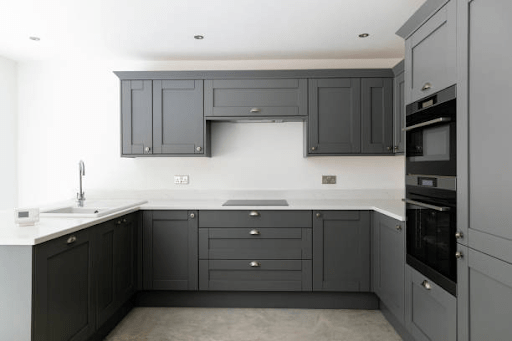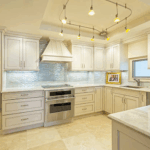Designing a kitchen or bathroom isn’t only about picking things that look good on their own. What really makes the space shine is how well everything works together. Cabinets, countertops, and flooring are the biggest parts of the room, and they set the whole mood. If they clash, the space feels awkward. But when they blend in harmony, the room feels warm, stylish, and inviting.
This guide walks you through how to match cabinets, counters, and floors without feeling lost in endless choices.
Why Matching Matters
Cabinets, countertops, and flooring cover most of the surface in your kitchen. Together, they create the first impression of the room. If one of them feels off, the balance is gone. But when the colors, textures, and tones flow, your kitchen feels complete.
Take wood shaker style cabinets in Milwaukee as an example. Their timeless design can look stunning, but the impact depends on how you pair them with the right flooring and counters. In the same way, choosing reliable brands like columbus cabinets gives you a strong base, but it’s your styling that turns the room into something special.
Step 1: Start with Cabinets
Cabinets as the Anchor
Cabinets grab attention first. They’re right at eye level and cover more space than anything else. That makes them the anchor of your design. Start here, and everything else becomes easier to match.
Popular Styles
- Wood shaker style cabinets – clean, timeless, and flexible.
- Glossy white cabinets – modern and fresh.
- Dark espresso cabinets – bold and dramatic.
Once you’ve picked your cabinet style, you can shift your focus to finding floors and countertops that support the look instead of fighting against it.
Step 2: Balance with Countertops
Countertops connect the cabinets and the flooring. They literally touch both, so they should act as a bridge that ties everything together.
Matching Tips
- Contrast helps. Dark cabinets love lighter counters. White cabinets shine against darker or patterned counters.
- Mind the patterns. If your countertop has big veining or bold speckles, keep your cabinets simple.
- Pick the right material. Granite feels natural, quartz is polished, and marble adds a softer vibe.
For example, columbus cabinets in Milwaukee with a warm wood finish look perfect with creamy quartz counters. Add a textured backsplash and the whole design feels cozy and balanced.
Step 3: Flooring Brings It All Together
Flooring is sometimes overlooked, but it has the power to ground the design or throw it off balance. Since it sits under everything, it must support your choices above it.
Key Rules
- Don’t pick floors that match cabinets too closely in tone. A little contrast keeps the space from feeling flat.
- Use floor colors to balance weight. Light floors soften dark cabinets, while dark floors anchor light cabinets.
- Think about daily use. Light tiles hide dust, while darker shades hide scratches.
For instance, white wood shaker style cabinets in Milwaukee with light oak flooring and a gray quartz countertop create a bright, airy kitchen. Walnut shaker cabinets paired with pale stone flooring, on the other hand, bring a warm but classic feel.
Step 4: Choose Your Color Palette
Colors make or break a kitchen. Keep these simple rules in mind:
- Stick with neutrals for the main pieces, then bring in accents with paint or décor.
- Tone-on-tone works well for a clean look. White cabinets, white counters, and soft gray flooring feel fresh and modern.
- Match undertones. Warm cabinets with warm flooring, cool cabinets with cool flooring. Mixing them creates a clash.
Step 5: Don’t Forget Lighting
Light changes how surfaces look. A counter that looks cream in a store can look yellow at home. Always bring samples and test them under both daylight and artificial light before deciding.
Step 6: Add Your Personal Touch
At the end of the day, it’s your kitchen. If you love bold contrasts, go for them. If you like calm flow, stick with softer tones. Mix textures too—matte cabinets with glossy counters or rustic floors with polished stone create personality.
Real-Life Design Examples
Modern Farmhouse
- Cabinets: White wood shaker style cabinets
- Countertops: Butcher block or light quartz
- Flooring: Medium-toned hardwood
- Look: Bright, cozy, and welcoming
Sleek and Contemporary
- Cabinets: Grey flat-panel from columbus cabinets
- Countertops: Black quartz with soft veining
- Flooring: Light concrete tile
- Look: Minimal and stylish
Warm and Traditional
- Cabinets: Walnut shaker
- Countertops: Cream granite
- Flooring: Light stone tile
- Look: Timeless and comfortable
Mistakes to Avoid
- Too much wood in one tone. It makes the room feel heavy.
- Forgetting undertones. Warm and cool surfaces don’t always mix.
- Thinking only of your taste when planning resale. Neutral choices attract more buyers.
Final Thoughts
Designing a kitchen doesn’t have to feel stressful. Start with cabinets, pick countertops that balance them, and choose flooring that grounds the space. Always test tones, textures, and lighting before making big decisions.
From wood shaker style cabinets to sleek modern choices from columbus cabinets in Milwaukee, your goal should be harmony. When cabinets, countertops, and floors work together, your kitchen becomes a place you’ll love for years.
FAQs
Q1: What cabinets work best in smaller kitchens?
Lighter cabinets, like white shaker or soft gray, help small kitchens feel more open.
Q2: Can I mix wood cabinets with wood flooring?
Yes, but choose different shades or finishes so they don’t blend too much.
Q3: What countertop material is easiest to maintain?
Quartz is low-maintenance, durable, and doesn’t stain as easily as natural stone.
Q4: Do neutral kitchens look boring?
Not at all. Neutrals give you freedom to add pops of color with décor, paint, and accessories.
Visit classicstylemag for more informative blogs.



